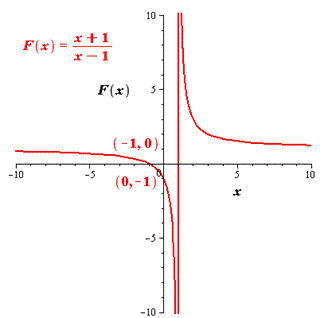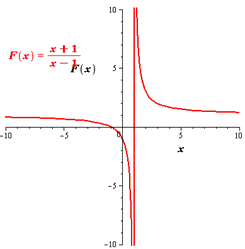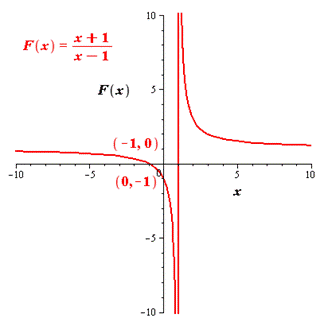
Concept explainers
To discuss: the given rational function
Answer to Problem 34RE
The graph of this function is as follows:

Explanation of Solution
Given:
Calculation:
Let us consider the following polynomial function.
We apply 8 steps to analyze the rational function.
Step 1
We factor the numerator and denominator of the function and find the domain of the function,
Thus, the domain of the function is
Step 2
Now, we write
Since, there are no more common factors between numerator and denominator therefore
Step 3
The
So,
Since, zero is the domain of
Step 4
Now, we test for symmetry if
So
We conclude that, neither
Step 5
We locate the vertical asymptotes by finding the zeros of the denominator with the rationalfunction in lowest terms. With
Step 6
Since the degree of numerator equals degree of numerator, therefore the graph is horizontal. The leading coefficient of numerator is 1 and the leading coefficient of denominator is 1. To determine the graph of
The only solution
Step 7
From the graph we can see that graph of

Step 8:
The graph of this function is as follows:

Conclusion:
Thus, the given relation is discussed
Chapter 4 Solutions
Precalculus
Additional Math Textbook Solutions
Introductory Statistics
Algebra and Trigonometry (6th Edition)
Intro Stats, Books a la Carte Edition (5th Edition)
College Algebra (7th Edition)
Calculus: Early Transcendentals (2nd Edition)
University Calculus: Early Transcendentals (4th Edition)
- 9. a) Determie values of a and b so that the function is continuous. ax - 2b f(x) 2 x≤-2 -2x+a, x ≥2 \-ax² - bx + 1, −2 < x < 2) 9b) Consider f(x): = 2x²+x-3 x-b and determine all the values of b such that f(x) does not have a vertical asymptote. Show work.arrow_forwardPls help ASAParrow_forward10. Evaluate showing work: lim √√x|x-c\ x→ c- (x-c)arrow_forward
 Calculus: Early TranscendentalsCalculusISBN:9781285741550Author:James StewartPublisher:Cengage Learning
Calculus: Early TranscendentalsCalculusISBN:9781285741550Author:James StewartPublisher:Cengage Learning Thomas' Calculus (14th Edition)CalculusISBN:9780134438986Author:Joel R. Hass, Christopher E. Heil, Maurice D. WeirPublisher:PEARSON
Thomas' Calculus (14th Edition)CalculusISBN:9780134438986Author:Joel R. Hass, Christopher E. Heil, Maurice D. WeirPublisher:PEARSON Calculus: Early Transcendentals (3rd Edition)CalculusISBN:9780134763644Author:William L. Briggs, Lyle Cochran, Bernard Gillett, Eric SchulzPublisher:PEARSON
Calculus: Early Transcendentals (3rd Edition)CalculusISBN:9780134763644Author:William L. Briggs, Lyle Cochran, Bernard Gillett, Eric SchulzPublisher:PEARSON Calculus: Early TranscendentalsCalculusISBN:9781319050740Author:Jon Rogawski, Colin Adams, Robert FranzosaPublisher:W. H. Freeman
Calculus: Early TranscendentalsCalculusISBN:9781319050740Author:Jon Rogawski, Colin Adams, Robert FranzosaPublisher:W. H. Freeman
 Calculus: Early Transcendental FunctionsCalculusISBN:9781337552516Author:Ron Larson, Bruce H. EdwardsPublisher:Cengage Learning
Calculus: Early Transcendental FunctionsCalculusISBN:9781337552516Author:Ron Larson, Bruce H. EdwardsPublisher:Cengage Learning





